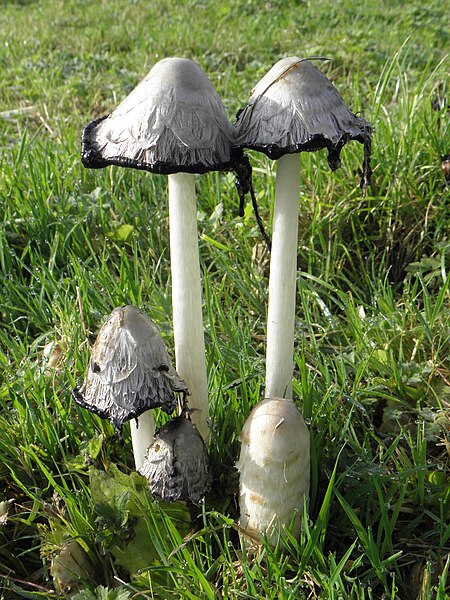Shaggy Ink Cap: A Mushroom that Can Clean Up a Mess
Posted in Interesting Plant Stories on July 9, 2015 by Maya Jaffe
Maya Jaffe graduated from Florida International University and has had an internship at the William and Lynda Steere Herbarium, where she has worked on a project to digitize macrofungi, the largest types of fungi, including mushrooms.

I sit behind drawn curtains in a dark room, illuminated only by light tents that are used for taking pictures. It’s another day on the job as an intern in the William and Lynda Steere Herbarium, where I am helping in an effort to digitize the New York Botanical Garden’s macrofungi. As I make my way alphabetically through the Agaricaceae family, I come across a shaggy ink cap specimen, Coprinus comatus, with a beautiful illustration.
Coprinus comatus is a common edible found in North American and European grasslands. It is a conspicuous mushroom, with a cylindrical white shaggy cap that becomes bell shaped as the mushroom matures and secretes a black liquid that is filled with spores.
Beyond its edibility when young, C. comatus fascinates me because it has been found to be a bioaccumulator of heavy metals, absorbing metals from the soil and concentrating them into the fruiting body. The implications of this are tremendous; this mushroom can potentially be used to sequester contaminants in soil.

This concept of using fungi as a solution to cleaning up polluted landscapes is referred to as mycoremediation. Many mushrooms can aid in cleaning up polluted sites, and specifically, the shaggy ink cap has been found to hyperaccumulate the toxic metals cadmium, mercury, and arsenic. Mycoremediation works by inoculating contaminated soil with spores that can then bioaccumulate the metals in the soil, restoring the soil’s pH.
The exact mechanism by which C. comatus takes up metals is currently not known, but through powerful enzymes, this mushroom is able to bind metals from aqueous solution. The ink cap should not be overlooked as a component in an integrated strategy to clean up environmentally degraded sites. From mine tailings to agricultural waste, we can use mushrooms to remediate soil and take another step toward solving a stubborn pollution problem.
Further Reading:
Dulay, RMR. “Growth Response and Mycoremediation Activity of Coprinus Comatus on Heavy Metal Contaminated Media.” Mycosphere 6.1 (2015): 1-7.
Dulay, RMR. “Aseptic Cultivation of Coprinus Comatus (O. F. Mull.) Gray on Various Pulp and Paper Wastes.” Mycosphere 3.3 (2012): 392-97.


This is very interesting. I’m curious – what happens at the end of the season? Do the mushrooms have to be harvested? If the mushroom dies in place and decays, won’t the heavy metals just be released back into the soil? Or is it enough that each growing season the mushroom biomass holds on to the heavy metals, and the metals have a lesser impact in the soil in the winter season?